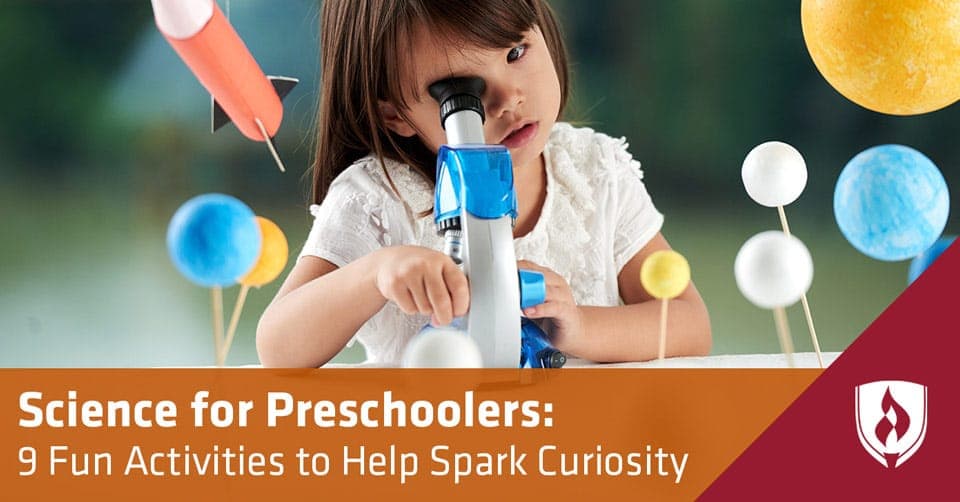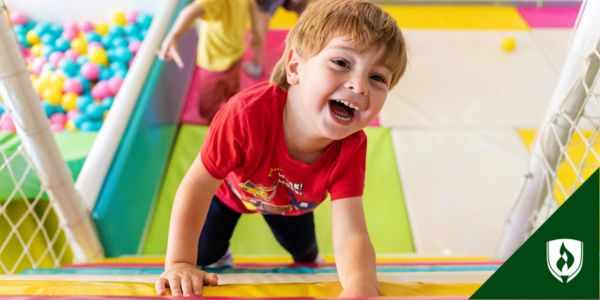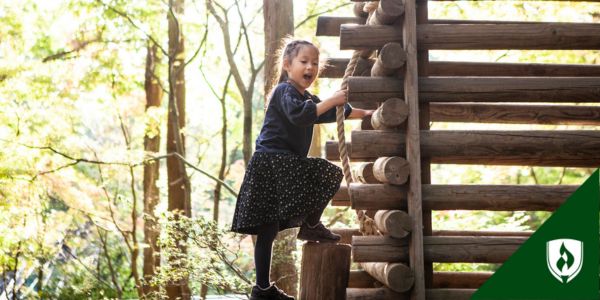Science for Preschoolers: 9 Fun Activities to Help Spark Curiosity
By Anjali Stenquist on 04/06/2020

Early childhood experiences can spark a lifelong love of learning. As children grow up, an early interest in science can support their work in the classroom. But how do you best engage children with play-based learning activities that build a foundation of curiosity about how the world works?
“In the preschool years, science all begins with questions,” says Pamela Morris, Early Childhood Education Director at the East Valley JCC. “The best science activities begin with a question that the child asks, but as a parent and a teacher, you can encourage this type of thinking by posing those questions back to them.”
Engaging children with dynamic learning experiences empowers them to seek out answers to their questions through exploration and experimentation. We spoke with experts in early childhood education to compile a list of nine fun activities to help spark curiosity in preschool aged children.
Why introduce preschoolers to science?
“Preschool-aged children are scientists,” says Megan Hughes, an educator at Hilltop Children’s Center. “They are constantly testing the world around them to develop theories about how things work. When a child knocks over a block tower, they see the effect of gravity. When a child washes their painty hands, they see paint mix into the water to make a solution. How often has your child asked you, ‘Why?’”
Nurturing this innate curiosity can help build critical thinking and reasoning skills children will use throughout their lifetime, in the sciences and beyond.
“As a science educator, my goal is not to teach children the ‘right’ answer but to give them the tools they need to generate their own theories and then test their ideas for logic, validity and accuracy,” explains Hughes. “My ultimate goal is to help children dig deeper into their thinking and reasoning.”
9 Activities for the tiny scientists in your life
Helping children focus and explore questions can be a part of almost any activity. Here are nine hands-on, child- and adult-approved activities to help to help spark and nurture curiosity:
1. Fizzy dissolving candy hearts
This simple experiment from Crazy Easy STEM allows children to explore how quickly sugar dissolves in different solutions. Using candy message hearts and three cups filled with water, vinegar, and soda—or any other liquids you have on hand—children can observe their “hearts melting.”
Boost the impact of this activity by asking children what they think will happen to the hearts, and why the hearts dissolve differently in the different solutions.
2. Life cycle of a frog
Metamorphosis is a pretty magical concept for learners at any age. Observing how a frog transitions from an egg, to a tadpole, to the jumping, ribbiting creatures in the neighborhood pond, can help children discover the wonders of the natural world.
This larger scale activity involves making a mini pond complete with frog eggs, tadpoles, adult frogs and a few lily pads. Former Early Years Teacher and blogger Sarah Hurst utilizes household objects to make slime for the pond and frog eggs out of chia seeds. Creating the pond is an investment in time, but offers children a fantastic tactile learning experience and play based exploration—and is sure to be a hit with any little ones infatuated with frogs!
3. Grow plants from food scraps
Did you know an avocado placed on top of a jar of water will begin to sprout? This activity from Modern Parents Messy Kids can demonstrate how plants grow by using recycled food scraps to create a small kitchen garden. Children can create a chart tracking the growth and changes to each plant. Children can see firsthand how a root system develops to provide nutrients to a growing plant. Placing the growing plants in sunlight allows children to see that sunlight is also critical for plant growth and photosynthesis.
4. The science of ice cream
Nothing can quite compare to the delicious science of making ice cream. This activity from Bright Hub Education involves using rock salt and a zip lock bag to make the ice cream and can be done in a large batch or with individual portions with different flavors.
Cooking with children can introduce concepts like how matter changes from a liquid to a solid and demonstrate the five senses as children look, smell, taste and touch food. Making ice cream is a safe, fun and sweet way to explore these concepts with young children. Plus, the end product is practically a sure-fire hit.
5. Colored flowers
This experiment from Fun Learning for Kids requires white flowers (carnations, daisies, or any other white flower you have available), a few glasses, food coloring, water and a little patience. By placing the flowers in colored water you can demonstrate how flowers take in water through their stems. The beautiful color change is a pretty side effect—with petals that could be potentially used in other crafts or decorations.
6. Cloud in a jar
This activity from Little Bins for Little Hands demonstrates that with a jar, ice, hot water and hair spray, you can replicate the conditions for cloud formation in a few minutes. Clouds need warm moist air, a cooling process, and a catalyst to start forming (in this case the aerosol spray). By opening the lid of the jar, children can watch the cloud release back into the air.
Creating a cloud on a small scale piques curiosity into weather formations and also offers the opportunity to explore how water changes from a liquid to a gas. This can also help build weather-related vocabulary around the different types of precipitation they’ve seen.
7. How do arctic animals stay warm?
There are many variations on this experiment demonstrating how fat protects mammals living in cold climates. This version uses two zip lock bags to facilitate easy clean up.
Using vegetable shorting and a bucket of ice water children can experience how fat keeps their hands warm in near-arctic temperatures. This activity can be incorporated into a lesson about the arctic climate, or a discussion what makes an animal a mammal.
8. Tornado in a bottle
While tornados may be a “scary” subject for some children—it’s no fun to hear sirens and hunker down in a basement, after all—this activity can help put these powerful natural forces into perspective. Similar to the cloud in a jar, this activity creates a mini weather condition for children to create and observe. This experiment requires a bottle with a tight lid, water, dish soap and glitter. By spinning the bottle centripetal force creates a vortex in the water that mimics the shape of a tornado.
9. Water music
This activity blends together scientific principles with pure creative expression. Filling a series of glasses with descending levels of water (plastic or glass work just fine) and gently tapping them with small batons creates a water-glass xylophone for children to make music. Students can explore why the water in the glasses creates different sounds as they learn through play.
Early childhood education in and out of the classroom
Combining elements of play and learning in activities for preschool aged children can help them develop reasoning skills and scientific curiosity.
“Preschool aged children need to see, touch, smell and hear science to begin to think about the world in a way that will encourage them to pursue science,” says Emily Watson, director of Ivybook Academy Greenville. “You don’t teach them abstract concepts at this age, you show them the world right in front of them and help them try to understand why and how it is.”
What are the last implications of early childhood learning? Take a look at our article, “5 Reasons Why the Importance of ECE Is Impossible to Ignore.”
Related Articles:
- 10 Engaging Outdoor Learning Activities for Kids
- Fresh Air and Bright Minds: 10 Outdoor Learning Activities for Preschoolers
- 14 Fun Fall Activities for Preschoolers
- 16 Simple Science Activities for Kids that Will Pique Their Curiosity
- Get Movin': 15 Fun Fitness Activities for Kids
- Preschool Technology: Do's & Don'ts of Devices in the Classroom




